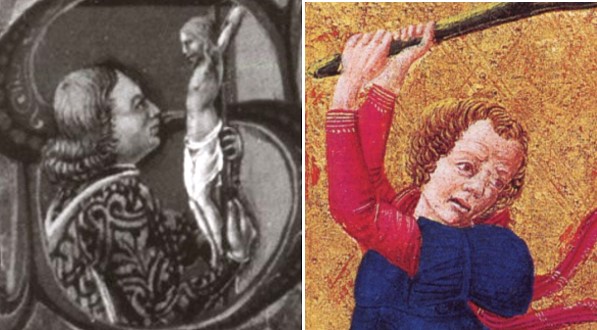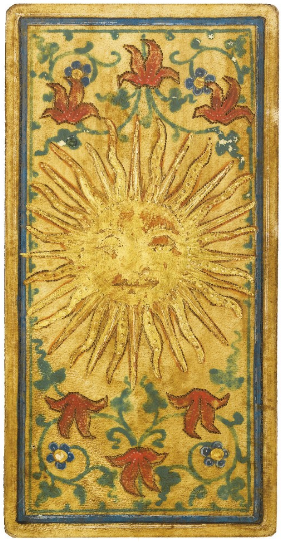still I've only limited computer access.
Possibly Bona identified her husband with the phoenix after his death. At least ... if the observation is correct, that Bona took the phoenix on a coin of Milanese money (in the short time, when she reigned), this seems plausible.mikeh wrote:
I would say, that the Brera-Brambilla is a different edition, long before the two others. The gold might be similar to PMB 2, but it wouldn't tell too much. The artists got gold leaves to work with, they couldn't control, if it was thicker or thinner, also it isn't clear, if the difference was seen immediately or developed with the time. We can assume, that the golden background between artist 1 and artist 2 from PBM differs, but it's difficult to win of it a comment for other decks.Now, Huck, here are some thoughts about some of your remarks on other subjects:
(1) If the thinner gold paint lasts longer, and it was used in the added PMB cards either later than the paint used in the original PMB or by a different workshop, what does that say about the Brera-Brambilla? I have not seen the actual cards, but from photos and people's reports, they really glisten, compared with the CY and the PMB, and close in shine to the Charles VI and some of the PMB-style partial decks. For color photos of examples see http://www.christies.com/LotFinder/lot_ ... ID=5148235.
And in this case (king of cups): Kaplan in 1978 knows not a king of cups of Brera-Brambilla (Kaplan p. 64), so this seems to a "new" old card ... why do we know, that it is from Brera-Brambilla? Actually the site, that you noted, says, it belongs to the Bonomi cards. Kaplan II (not I), p. 22-23 (which indeed show a king of cups)
It seems, you've an error there, though it's nice, that you found this picture.
Neither it seems likely, that Borso would have loved himself as Hercules, nor I would assume, that he really looked in this way.(2) I have been examining Madonnas in Ferrara (by e.g. Tura, del Cossa, and the miniaturists Giraldi and Crivelli) to see if any resemble the PMB lady of the second artist. I find the receding hairline, but not the pursed lips.
(3) I have been looking at male figures, too, in hopes of getting more clarity about the man on the Fortitude card. I know that some people, including me, identify him with Francesco Sforza, but the image doesn't correspond to Francesco's portraits. I noticed a nice portrait of Borso and thought I detected a resemblance to the lion-beater:
Another portrait, showing him older, is at http://en.wikipedia.org/wiki/Borso_d%27 ... of_Ferrara. Could the PMB Fortitude be a portrait of Borso as Hercules?
Wikipedia isn't always correct. Probably the relations between Ferrara and Milan were good till Francesco's death (for instance: Ercole was a guest at Ippolita's wedding, which is short before Francesco's death) ... the battle of Molinella wouldn't have taken place, if Francesco had still lived in 1467. Things went worse, when Galeazzo became ruler. He tried to trigger a Ferrarese rebellion against Borso in 1469.If so, I wouldn't think that it was done during Borso's lifetime. According to Wikipedia in the article just cited, Borso and Francesco were not on friendly terms. Here is Wikipedia:
. This animosity presents a problem for your idea that Borso was familiar with the PMB cards, so correct me if Wikipedia is wrong.He was generally allied with the Republic of Venice, and enemy both to Francesco I Sforza and the Medici family. These rivalries led to the indecisive Battle of Molinella. That battle was in 1467 (http://www.comune.molinella.bo.it/model ... aspx?ID=71)
Venice - Ferrara - Milan developed together "most peaceful relations" (comparing it to other times in the same century) after the Ferrarese wars. ...However Galeazzo could have wanted a deliberate resemblance to Borso after his death in 1471, as a gesture of goodwill to Ercole (communicated through emissaries) and a tribute to Borso and Francesco both. In fact, as I understand it, Ercole did ally Ferrara with Milan after Milan helped in Ferrara’s 1482-1484 war against Venice (http://en.wikipedia.org/wiki/War_of_Ferrara). I am acknowledging your point about how the Hercules legend was adopted by the d'Estes, but still coming to my conclusion rather than yours, that the card was probably Galeazzo's late idea.




